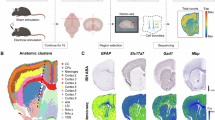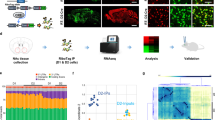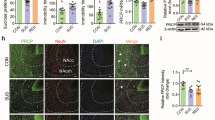Abstract
Depression is a leading cause of disease burden, yet current therapies fully treat <50% of affected individuals. Increasing evidence implicates epigenetic mechanisms in depression and antidepressant action. Here we examined a possible role for the DNA dioxygenase, ten-eleven translocation protein 1 (TET1), in depression-related behavioral abnormalities. We applied chronic social defeat stress, an ethologically validated mouse model of depression-like behaviors, and examined Tet1 expression changes in nucleus accumbens (NAc), a key brain reward region. We show decreased Tet1 expression in NAc in stress-susceptible mice only. Surprisingly, selective knockout of Tet1 in NAc neurons of adult mice produced antidepressant-like effects in several behavioral assays. To identify Tet1 targets that mediate these actions, we performed RNAseq on NAc after conditional deletion of Tet1 and found that immune-related genes are the most highly dysregulated. Moreover, many of these genes are also upregulated in the NAc of resilient mice after chronic social defeat stress. These findings reveal a novel role for TET1, an enzyme important for DNA hydroxymethylation, in the brain’s reward circuitry in modulating stress responses in mice. We also identify a subset of genes that are regulated by TET1 in this circuitry. These findings provide new insight into the pathophysiology of depression, which can aid in future antidepressant drug discovery efforts.
Similar content being viewed by others
Log in or create a free account to read this content
Gain free access to this article, as well as selected content from this journal and more on nature.com
or
References
Akbarian S (2014). Epigenetic mechanisms in schizophrenia. Dialogues Clin Neurosci 16: 405–417.
Bagot RC, Cates HM, Purushothaman I, Lorsch ZS, Walker DM, Wang J et al (2016). Circuit-wide transcriptional profiling reveals brain region-specific gene networks regulating depression susceptibility. Neuron 90: 969–983.
Bagot RC, Labonte B, Pena CJ, Nestler EJ (2014). Epigenetic signaling in psychiatric disorders: stress and depression. Dialogues Clin Neurosci 16: 281–295.
Berton O, McClung CA, Dileone RJ, Krishnan V, Renthal W, Russo SJ et al (2006). Essential role of BDNF in the mesolimbic dopamine pathway in social defeat stress. Science 311: 864–868.
Boulanger LM, Shatz CJ (2004). Immune signalling in neural development, synaptic plasticity and disease. Nat Rev 5: 521–531.
Cheng Y, Bernstein A, Chen D, Jin P (2015). 5-Hydroxymethylcytosine: a new player in brain disorders? Exp Neurol 268: 3–9.
Dawlaty MM, Ganz K, Powell BE, Hu YC, Markoulaki S, Cheng AW et al (2011). Tet1 is dispensable for maintaining pluripotency and its loss is compatible with embryonic and postnatal development. Cell Stem Cell 9: 166–175.
Dias C, Feng J, Sun H, Shao NY, Mazei-Robison MS, Damez-Werno D et al (2014). beta-catenin mediates stress resilience through Dicer1/microRNA regulation. Nature 516: 51–55.
Fan G, Beard C, Chen RZ, Csankovszki G, Sun Y, Siniaia M et al (2001). DNA hypomethylation perturbs the function and survival of CNS neurons in postnatal animals. J Neurosci 21: 788–797.
Feng J, Shao N, Szulwach KE, Vialou V, Huynh J, Zhong C et al (2015). Role of Tet1 and 5-hydroxymethylcytosine in cocaine action. Nat Neurosci 18: 536–544.
Feng J, Wilkinson M, Liu X, Purushothaman I, Ferguson D, Vialou V et al (2014). Chronic cocaine-regulated epigenomic changes in mouse nucleus accumbens. Genome Biol 15: R65.
Feng J, Zhou Y, Campbell SL, Le T, Li E, Sweatt JD et al (2010). Dnmt1 and Dnmt3a maintain DNA methylation and regulate synaptic function in adult forebrain neurons. Nat Neurosci 13: 423–430.
Golden SA, Covington HE 3rd, Berton O, Russo SJ (2011). A standardized protocol for repeated social defeat stress in mice. Nat Protoc 6: 1183–1191.
Guidotti A, Dong E, Gavin DP, Veldic M, Zhao W, Bhaumik DK et al (2013). DNA methylation/demethylation network expression in psychotic patients with a history of alcohol abuse. Alcohol Clin Exp Res 37: 417–424.
Guo JU, Su Y, Zhong C, Ming GL, Song H (2011). Hydroxylation of 5-methylcytosine by TET1 promotes active DNA demethylation in the adult brain. Cell 145: 423–434.
Hodes GE, Kana V, Menard C, Merad M, Russo SJ (2015). Neuroimmune mechanisms of depression. Nat Neurosci 18: 1386–1393.
Huang, da W, Sherman BT, Lempicki RA (2009). Systematic and integrative analysis of large gene lists using DAVID bioinformatics resources. Nat Protoc 4: 44–57.
Huh GS, Boulanger LM, Du H, Riquelme PA, Brotz TM, Shatz CJ (2000). Functional requirement for class I MHC in CNS development and plasticity. Science 290: 2155–2159.
Hyman S (2014). Mental health: depression needs large human-genetics studies. Nature 515: 189–191.
Jaenisch R, Bird A (2003). Epigenetic regulation of gene expression: how the genome integrates intrinsic and environmental signals. Nat Genet 33: 245–254.
Kaas GA, Zhong C, Eason DE, Ross DL, Vachhani RV, Ming GL et al (2013). TET1 controls CNS 5-methylcytosine hydroxylation, active DNA demethylation, gene transcription, and memory formation. Neuron 79: 1086–1093.
Kriaucionis S, Heintz N (2009). The nuclear DNA base 5-hydroxymethylcytosine is present in Purkinje neurons and the brain. Science 324: 929–930.
Krishnan V, Han MH, Graham DL, Berton O, Renthal W, Russo SJ et al (2007). Molecular adaptations underlying susceptibility and resistance to social defeat in brain reward regions. Cell 131: 391–404.
Krishnan V, Nestler EJ (2008). The molecular neurobiology of depression. Nature 455: 894–902.
LaPlant Q, Vialou V, Covington HE 3rd, Dumitriu D, Feng J, Warren BL et al (2010). Dnmt3a regulates emotional behavior and spine plasticity in the nucleus accumbens. Nat Neurosci 13: 1137–1143.
Law CW, Chen Y, Shi W, Smyth GK (2014). voom: Precision weights unlock linear model analysis tools for RNA-seq read counts. Genome Biol 15: R29.
Li X, Wei W, Zhao QY, Widagdo J, Baker-Andresen D, Flavell CR et al (2014). Neocortical Tet3-mediated accumulation of 5-hydroxymethylcytosine promotes rapid behavioral adaptation. Proc Natl Acad Sci USA 111: 7120–7125.
Miller CA, Sweatt JD (2007). Covalent modification of DNA regulates memory formation. Neuron 53: 857–869.
Neumann H, Schmidt H, Cavalie A, Jenne D, Wekerle H (1997). Major histocompatibility complex (MHC) class I gene expression in single neurons of the central nervous system: differential regulation by interferon (IFN)-gamma and tumor necrosis factor (TNF)-alpha. J Exp Med 185: 305–316.
Rudenko A, Dawlaty MM, Seo J, Cheng AW, Meng J, Le T et al (2013). Tet1 is critical for neuronal activity-regulated gene expression and memory extinction. Neuron 79: 1109–1122.
Russo SJ, Nestler EJ (2013). The brain reward circuitry in mood disorders. Nat Rev 14: 609–625.
Stephan AH, Barres BA, Stevens B (2012). The complement system: an unexpected role in synaptic pruning during development and disease. Annu Rev Neurosci 35: 369–389.
Sun H, Damez-Werno DM, Scobie KN, Shao NY, Dias C, Rabkin J et al (2015). ACF chromatin-remodeling complex mediates stress-induced depressive-like behavior. Nat Med 21: 1146–1153.
Szulwach KE, Li X, Li Y, Song CX, Wu H, Dai Q et al (2011). 5-hmC-mediated epigenetic dynamics during postnatal neurodevelopment and aging. Nat Neurosci 14: 1607–1616.
Tahiliani M, Koh KP, Shen Y, Pastor WA, Bandukwala H, Brudno Y et al (2009). Conversion of 5-methylcytosine to 5-hydroxymethylcytosine in mammalian DNA by MLL partner TET1. Science 324: 930–935.
Turecki G, Meaney MJ (2016). Effects of the social environment and stress on glucocorticoid receptor gene methylation: a systematicreview. Biol Psychiatry 79: 87–96.
Vialou V, Feng J, Robison AJ, Nestler EJ (2013). Epigenetic mechanisms of depression and antidepressant action. Annu Rev Pharmacol Toxicol 53: 59–87.
Yu H, Su Y, Shin J, Zhong C, Guo JU, Weng YL et al (2015). Tet3 regulates synaptic transmission and homeostatic plasticity via DNA oxidation and repair. Nat Neurosci 18: 836–843.
Zhang RR, Cui QY, Murai K, Lim YC, Smith ZD, Jin S et al (2013). Tet1 regulates adult hippocampal neurogenesis and cognition. Cell Stem Cell 13: 237–245.
Zhao Z, Chen L, Dawlaty MM, Pan F, Weeks O, Zhou Y et al (2015). Combined loss of Tet1 and Tet2 promotes B cell, but not myeloid malignancies, in mice. Cell Rep 13: 1692–1704.
Author information
Authors and Affiliations
Corresponding author
Rights and permissions
About this article
Cite this article
Feng, J., Pena, C., Purushothaman, I. et al. Tet1 in Nucleus Accumbens Opposes Depression- and Anxiety-Like Behaviors. Neuropsychopharmacol 42, 1657–1669 (2017). https://doi.org/10.1038/npp.2017.6
Received:
Revised:
Accepted:
Published:
Issue date:
DOI: https://doi.org/10.1038/npp.2017.6
This article is cited by
-
Auditory cortical neurons are recruited to encode fear signals and anxiety by neuroligin-3-mediated synapse formation
Translational Psychiatry (2025)
-
Associative memory cells of encoding fear signals and anxiety are recruited by neuroligin-3-mediated synapse formation
Communications Biology (2024)
-
Post-stroke depression: epigenetic and epitranscriptomic modifications and their interplay with gut microbiota
Molecular Psychiatry (2023)
-
Tet Enzyme-Mediated Response in Environmental Stress and Stress-Related Psychiatric Diseases
Molecular Neurobiology (2023)
-
Tet3 Deletion in Adult Brain Neurons of Female Mice Results in Anxiety-like Behavior and Cognitive Impairments
Molecular Neurobiology (2022)



